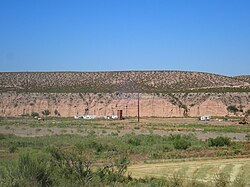Earth:Palomas Formation
| Palomas Formation Stratigraphic range: Pliocene to Quaternary 5–0.4 Ma | |
|---|---|
 Palomas Formation (pink beds in erosional escarpment) near its type section, Palomas Creek, New Mexico, USA | |
| Type | Formation |
| Unit of | Santa Fe Group (geology) |
| Overlies | Hayner Ranch Formation |
| Thickness | 300–2,000 feet (91–610 m) |
| Lithology | |
| Primary | conglomerate |
| Other | Sandstone, siltstone |
| Location | |
| Coordinates | [ ⚑ ] 33°03′16″N 107°17′45″W / 33.0545°N 107.2959°W |
| Region | New Mexico |
| Country | United States |
| Type section | |
| Named for | Palomas River |
| Named by | C.H. Gordon |
| Year defined | 1907 |
The Palomas Formation is a geologic formation exposed in the southern Rio Grande rift of New Mexico. It preserves fossils dating back to the Pliocene to Quaternary.[1]
Description
The formation is composed of beds of poorly cemented conglomerate, sandstone, and siltstone, with a total thickness of 300–2,000 feet (91–610 m).[2][1] The formation is better cemented to the west, where it resembles the Gila Formation.[2] The conglomerate is gray to brown, poorly to moderately sorted, and contains clasts of tuff, basalt, rhyolite, and andesite up to 40 centimetres (16 in) long. The siltstone is well-sorted and trough-crossbedded. The formation may correlate with the Sierra Ladrones Formation to the north and the Camp Rice Formation to the south. The age is estimated as 5 million years (Ma) to 0.4 Ma.[1]
The formation includes both piedmont and axial river facies. The piedmont facies represents alluvial fans and other sediments deposited at the feet of the mountains surrounding the original depositional basin. The axial river facies represents deposition near the main channel of the ancestral Rio Grande River.[1]
The lower part of the formation contains two nested paleovalleys near Truth or Consequences, New Mexico, recording climate fluctuations that incised and then backfilled the valleys. The first was incised and backfilled between 5.1 and 4.87 Ma, while the second dates to 4.87 to 4.5 Ma. The lack of axial river facies in the Palomas Formation between the Palomas and Mesilla Basins may be due to confinement of flow to narrow paleovalleys in this area.[3]
Fossils
The lower part of the formation contains fossil mammals and reptiles, including turtles, lizards, snakes, rabbits, rats, gophers, mastodons, horses, and deer. Paleomagnetic dating gives an age for this bed of 4.05 to 4.20 Ma.[4]
History of investigation
The unit was first named the Palomas Gravel by C.H. Gordon in 1907.[2] It was renamed the Palomas Formation and assigned to the upper Santa Fe Group by Lozinsky and Hawley in 1986.[1] However, Reppening and May regard it as post-Santa Fe.[4]
See also
- List of fossiliferous stratigraphic units in New Mexico
- Paleontology in New Mexico
Footnotes
References
- Gordon, C.H.; Graton, L.C. (1907). "Lower Paleozoic formations in New Mexico". Journal of Geology 15 (1): 91–92. doi:10.1086/621378. PMID 17797346. Bibcode: 1907JG.....15...91..
- Koning, D.J.; Jochems, A.P.; Heizler, M.T. (2018). "Early Pliocene paleovalley incision during early Rio Grande evolution insouthern New Mexico". New Mexico Geological Society Field Conference Series 69: 93-108. https://nmgs.nmt.edu/publications/guidebooks/downloads/69/69_p0093_p0108.pdf. Retrieved 3 March 2021.
- Lozinsky, R.P.; Hawley, J.W. (1986). "The Palomas Formation of south-central New Mexico; a formal definition". New Mexico Geology 8 (4): 73–78, 82. https://geoinfo.nmt.edu/publications/periodicals/nmg/8/n4/nmg_v8_n4_p73.pdf. Retrieved 14 August 2020.
- Maxwell, C.H.; Oakman, M.R. (1990). "Geologic map of the Cuchillo quadrangle, Sierra County, New Mexico". U.S. Geological Survey Geologic Quadrangle Map GQ-1686. http://ngmdb.usgs.gov/Prodesc/proddesc_1197.htm. Retrieved 31 July 2020.
- Repenning, C.A.; May, S.R. (1986). "New evidence for the age of the lower part of the Palomas Formation, Truth or Consequences, New Mexico". New Mexico Geological Society Field Conference Guidebook 37: 257. https://nmgs.nmt.edu/publications/guidebooks/downloads/37/37_p0257_p0260.pdf. Retrieved 31 July 2020.
 |



